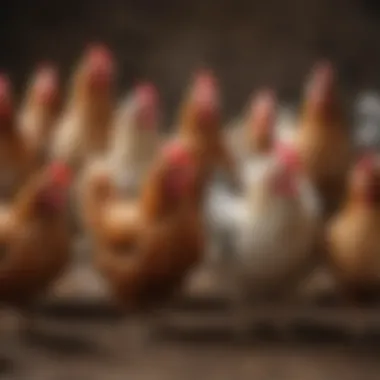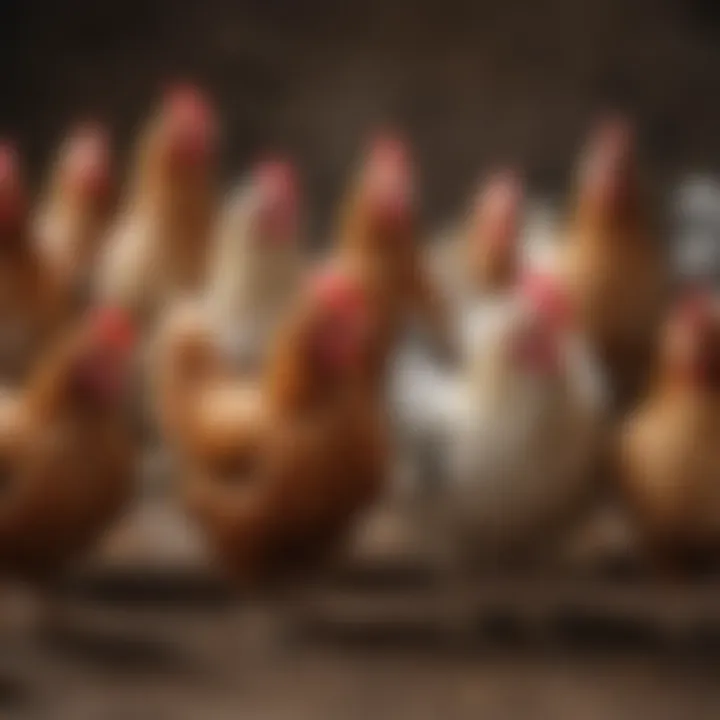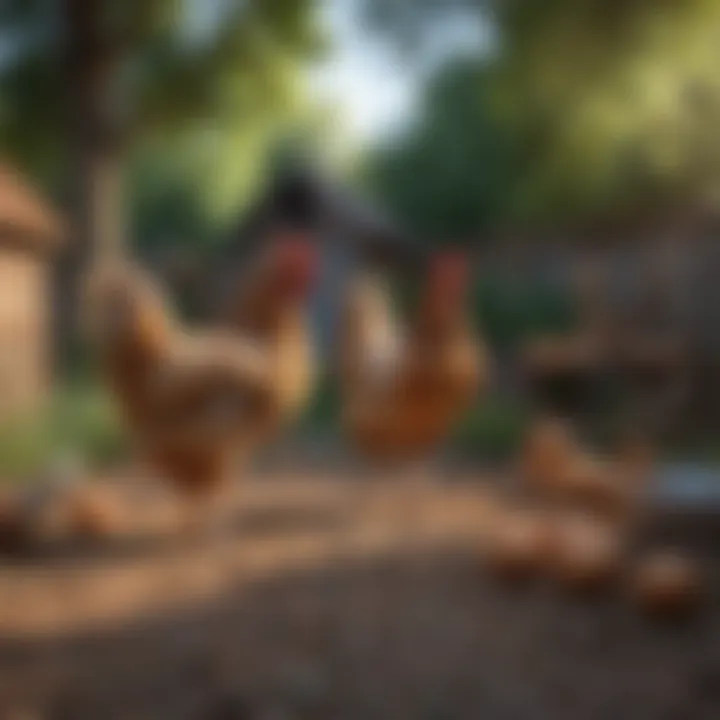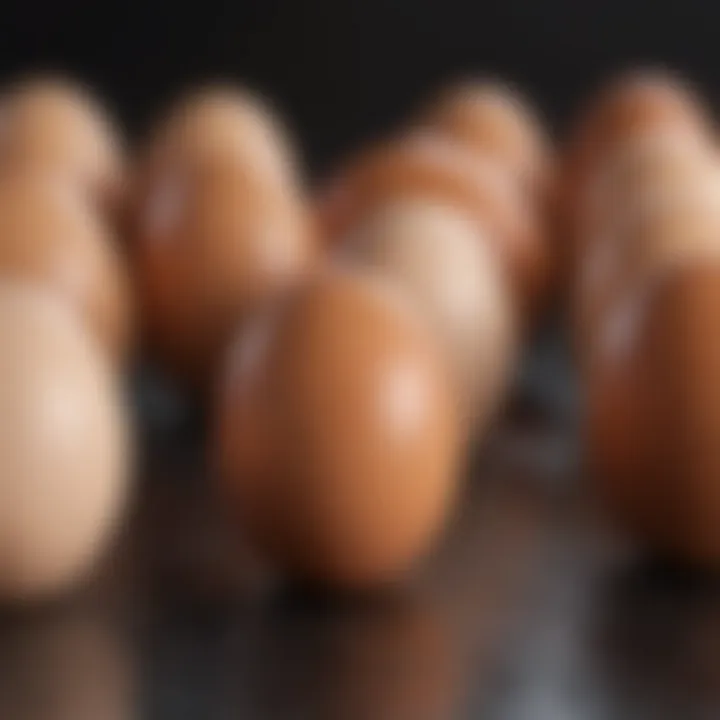Exploring Different Types of Chickens for Egg Production


Intro
Understanding the different breeds of chickens that lay eggs is essential for anyone interested in poultry farming. Selecting the right breed can influence egg production rates, the quality of eggs, and the overall experience of chicken ownership. In this article, we will explore a variety of chicken breeds known for their egg-laying capabilities, highlighting their characteristics, egg production statistics, and their adaptability to various environments.
With a range of breeds available, this guide aims to inform prospective chicken owners and enthusiasts about the options at their disposal. It provides insight into both common and rare breeds, catering to diverse preferences and needs. Readers will gain valuable knowledge that assists in making informed decisions regarding egg-laying chickens.
Pet Care and Grooming
Taking proper care of chickens is crucial for their wellbeing and productivity. While chickens may not require as much grooming as other pets, their care is essential for egg production and overall health.
Importance of Regular Care
Regular care can significantly impact the health of chickens. A clean environment helps prevent diseases that can affect egg production. Additionally, handling chickens gently and frequently can encourage them to be more sociable, making them more approachable.
Grooming Techniques by Chicken Type
Different breeds may have varying grooming requirements. For instance, the Plymouth Rock breed often develops heavy feathering, which could require occasional brushing to avoid matting. Conversely, the Leghorn, with its slender frame, needs less grooming. Monitor feather conditions and clean any dirt from feathers gently.
Tools and Products Recommendations
Investing in some basic tools can simplify the grooming process. Here are a few recommendations:
- A soft-bristle brush for removing dirt and dust
- Nail clippers specifically designed for poultry
- An easy-to-clean coop to maintain hygiene
Seasonal Care Tips
Chickens face different challenges throughout the seasons. Summer care may demand increased hydration and shade, while winter requires proper insulation and protection from drafts. Be observant and adjust care practices accordingly.
Health and Nutrition
The health and nutrition of chickens directly relate to their egg-laying efficiency. Educating yourself on these aspects is vital for creating a fostering environment for egg production.
Understanding Pet Nutrition
Nutrition is the backbone of chicken health. Providing high-quality feed, enriched with essential vitamins and minerals, can noticeably enhance egg production. Choose layers' feed that contains adequate calcium for strong eggshells.
Common Health Issues by Species
Different breeds have unique health concerns. For example, Rhode Island Reds may be prone to respiratory issues, while Orpingtons are known for their susceptibility to obesity. Regular health check-ups can help in identifying and addressing these issues promptly.
Preventive Care and Regular Check-Ups
Regular check-ups with a veterinarian familiar with poultry can help catch health issues early. Routine vaccinations and parasite control are essential aspects of preventive care.
Food and Dietary Advice
Consider supplementing chickens' diets with fresh fruits and vegetables. Omega-3 enriched foods may also improve egg quality. Furthermore, providing grit aids in digestion, particularly when chickens consume whole grains.
Behavioral Training
Understanding how to train chickens can enhance the relationship between farmer and fowl. Training techniques can help manage their behavior in domestic settings.
Basics of Positive Reinforcement
Positive reinforcement involves rewarding chickens for desired behaviors. This could involve treats given when they come to you on command, fostering a bond and encouraging friendly interactions.
Training Techniques Users Can Apply
Start training young chicks. Use treats to lure them and encourage desired actions, like entering the coop at dusk. Consistent practice runs can help integrate routine behaviors.
Managing Behavioral Issues
Identifying issues such as feather pecking is essential for maintaining a calm flock. Providing adequate space and distractions can alleviate these behaviors. Ensuring all chickens receive adequate attention can deter dominant behaviors.
Importance of Socialization
Chickens are social creatures. Introducing them to new environments or chickens should be done slowly to minimize stress. Socializing properly may help in reducing aggression and establishing a balanced pecking order.
Engaging Activities and Enrichment
Chickens need mental stimulation, and providing engaging activities can enhance their quality of life, keeping them active and satisfied.
Fun Games to Play with Your Pet
Utilizing activities like scatter feeding or providing hay to scratch in can significantly improve chickens' mental stimulation. Chickens will enjoy foraging through their environment, which mimics their natural instincts.
DIY Toys and Activities
Creating simple toys can be beneficial. Hanging vegetables or creating pecking blocks can provide essential entertainment while supporting their natural foraging behavior.
Importance of Mental Stimulation
A mentally stimulated chicken is typically a healthier chicken. Consider adding various enrichments in the coop, allowing chickens to explore and interact with different textures and scents.
Outdoor Adventures and Exploration


Allowing chickens outside regularly can help in exercising and exploring their surroundings. Provide plenty of space and safe areas for free-ranging to keep them engaged and active.
Resources and Community Engagement
Educating oneself continues beyond this article. There are numerous resources and community platforms available for chicken owners.
Recommended Books and Websites
Explore informative works like "Storey's Guide to Raising Chickens" and websites such as en.wikipedia.org and britannica.com to expand your knowledge.
Forums and Groups for Chicken Owners
Online communities, such as reddit.com groups dedicated to poultry, can provide assistance and camaraderie among fellow chicken owners.
Finding Local Services and Classes
Many areas offer local classes on poultry care and breeding. Engaging in these can provide practical experience and expand your network.
Encouraging Community Sharing and Contributions
Participating in local chicken shows or swapping breeds can be beneficial. These activities foster community spirit and enhance the collective knowledge regarding chicken care.
In summary, understanding the various chicken breeds and their care needs is essential for successful egg production. With this knowledge, prospective chicken owners can make informed choices, ensuring a productive and enriching experience.
Preamble to Egg-Laying Chickens
Choosing the right breed of chicken for egg production is essential for anyone interested in sustainable farming or keeping backyard birds for layers. Different breeds have unique characteristics that influence both the quality and quantity of eggs they produce. This not only affects how much eggs one can collect, but also the overall health and behavior of the birds. Understanding these differences can lead to more informed decisions and ultimately a more successful flock.
Importance of Choosing the Right Breed
Selecting a breed that suits your specific needs can greatly enhance your experience with egg-laying chickens. Different breeds offer varying degrees of egg production. For example, some breeds are known for their ability to lay a higher volume of eggs, while others may produce fewer eggs but exhibit superior egg quality.
It’s also crucial to consider the environment in which these birds will live. Some breeds thrive in certain climates better than others. Additionally, the availability of space, feed, and health management practices can also dictate which breed will perform best in a given setting. Therefore, making a deliberate choice can result in more rewarding egg-laying experiences.
Factors Influencing Egg Production
Several factors influence the rate at which chickens lay eggs. These include:
- Breed Characteristics: Each breed has unique patterns of egg production. For example, the Leghorn is renowned for its prolific laying capacity, while Orpingtons are often less consistent but may produce larger eggs.
- Age of the Hen: Young hens, or pullets, typically start laying eggs at around 5 to 6 months of age. As they age, their production can fluctuate, usually peaking in their second year before gradually declining.
- Nutrition: A well-balanced diet is essential for optimal egg production. Hens require the right ratios of protein, vitamins, and minerals for egg formation. Feeding them high-quality commercial feed or a carefully constructed homemade diet supports their egg-laying capabilities.
- Lighting Conditions: Hens need a certain amount of light to stimulate egg production. Usually, at least 14 to 16 hours of light is ideal. Supplemental lighting during shorter days can maintain consistent laying habits.
- Health and Stress Levels: Healthy chickens are more likely to be productive. Factors that contribute to stress, such as overcrowding, extreme weather, or inadequate shelter, can negatively impact their laying patterns.
"Proper management and understanding of your flock's environment can enhance egg production significantly."
Overall, knowing the interplay between these factors allows chicken owners to create an optimal setting for their egg-layers and enjoy the benefits of home-produced eggs.
Common Breeds of Egg-Laying Chickens
Common breeds of egg-laying chickens play a crucial role in poultry farming and backyard gardening. These breeds are generally known for their reliable egg production capabilities, making them suitable for various settings. Each breed has its unique characteristics that influence not only the quantity of eggs produced but also their quality and the care needed to maintain the birds. Understanding these common breeds assists prospective chicken owners in making well-informed decisions tailored to their specific needs.
Leghorn Chickens
Origins and History
Leghorn chickens have a long history, tracing back to Italy. They were introduced to America in the early 1800s, quickly gaining popularity due to their remarkable egg-laying abilities. Their origins reflect a breed bred for hardiness and efficiency, making them a favorite among commercial egg producers. The unique aspect of Leghorns is their high adaptability to different environments, allowing them to thrive in various conditions. This characteristic makes them a valuable choice for anyone looking to maximize egg production.
Egg Production Rates
The Leghorn is renowned for its impressive egg production rates, often laying 280 to 300 eggs per year. This high yield is a key characteristic, contributing significantly to their widespread adoption. The eggs are usually white, which is a preference for many consumers. One significant feature is their efficient feed conversion, where they translate feed into eggs effectively. This efficiency translates into economic benefits over time, adding to the appeal of this breed.
Care Requirements
In terms of care requirements, Leghorns are relatively low maintenance. They require a safe, clean environment to thrive, along with a balanced diet high in protein. Another vital aspect is their ability to withstand various weather conditions. However, they can be more skittish around humans than other breeds, making regular handling essential for socialization.
Rhode Island Red
Character Traits
Rhode Island Reds are robust and friendly chickens known for their hardiness. Originating in the United States, they were developed for both egg production and meat. One of the key features of this breed is its calm demeanor, making them suitable for families and small farms. This reliability makes them popular among chicken enthusiasts.
Egg Quality
Rhode Island Reds produce medium to large brown eggs, known for their rich flavor and high nutritional value. The color and quality of the eggs make them an attractive option for consumers. Their consistent egg quality is a major advantage, as it appeals to both backyard farmers and commercial operations alike.
Adaptability to Environment
This breed exhibits significant adaptability to different environments. They can endure both heat and cold better than many other breeds. The hardiness of Rhode Island Reds allows them to flourish in various climates, making them a versatile choice for diverse farming setups.
Plymouth Rock
Breed Characteristics
Plymouth Rock chickens have striking striped feathers, known for their beauty. They are friendly and good-natured birds, often recommended for families. Their friendly disposition makes them easy to handle, adding charm to any coop. Moreover, they are adaptable and can thrive in many environments, which contributes to their popularity among small-hold farmers.
Recent Popularity
In recent years, Plymouth Rock chickens have gained attention due to the rise in backyard farming and sustainable practices. Their attractive appearance and productive egg-laying capabilities make them desirable among enthusiasts. Many appreciate their dual-purpose nature, as they can also be raised for meat, enhancing their utility on small farms.


Feeding Needs
Plymouth Rock chickens require a balanced diet rich in protein and calcium to maintain optimal health and egg production. They thrive on a mixture of grains and greens. One unique aspect of feeding for this breed is their tendency to forage, which can reduce feed costs while providing natural nutrients.
Australorp
Origin and Development
Australorp chickens originated in Australia during the 1920s, and they are well-regarded for their exceptional egg-laying performance. They were bred from Black Orpingtons and became famous for producing a large number of eggs annually. This development highlights the breed's efficiency in egg production, which is a significant consideration for aspiring chicken owners.
Egg Production Efficiency
This breed is celebrated for its egg production efficiency, laying around 250 to 300 eggs each year. The eggs are medium to large and usually brown. This efficiency not only contributes to the overall productivity of the flock but also signifies the breed's value in both commercial settings and homesteads.
Social Behavior
Australorps are known for their friendly and sociable nature. They adapt well to coexisting with various breeds, making them a harmonious addition to any flock. The positive social behavior enhances the overall experience of raising chickens, as they can become quite affectionate toward their caretakers.
Heritage and Specialty Breeds
Heritage and specialty breeds represent a significant aspect of the chicken community. These breeds have established backgrounds and particular traits that appeal to many owners. Understanding these elements can help in better decision-making for egg production. Heritage breeds are often praised for their longevity and resilience. They typically adapt well to various environments and tend to have higher genetic diversity, which is beneficial for sustainable practices.
Orpingtons
History of the Breed
Orpington chickens originated in the late 19th century in England. They were created by William Cook, who aimed to develop a bird with a good combination of meat and egg-laying abilities. This breed has a charming and friendly disposition, which can attract potential owners. The historical significance lies not just in their utility but also in their role in supporting backyard chicken farming as a popular trend during that era. Their adaptable nature makes them a great choice for diverse environments.
Egg-Laying Capacity
Orpingtons are renowned for their exceptional egg-laying capability. They typically produce around 200 to 280 eggs annually. Their large brown eggs are a particular favorite among consumers. This breed's ability to lay consistently places them among the top choices for egg-laying chickens. However, production can be slightly lower in winter months. Despite this, their consistent performance makes them worthwhile for egg production.
Breeding Practices
Breeding practices for Orpingtons focus on maintaining their unique characteristics. They are often bred for not only their egg-laying capabilities but also for good temperament and overall health. This breed is known for its genetic stability. Some breeders may even focus on specific colors, like black or blue. While this can enhance visual appeal, it is important to maintain the essential traits related to egg production. Overall, Orpingtons provide a well-rounded option for anyone focused on egg-laying.
Sussex Chickens
Varieties of Sussex
Sussex chickens come in various colors and types, including Red, White, and Speckled. Each variety has its own particular characteristics that appeal to specific audiences. Red Sussex is known for its ability to adapt well to both free-range and confined environments. The White Sussex is considered a favorite for egg production, laying approximately 250 eggs yearly. Such diversity allows for choices based on personal preferences, making Sussex an adaptable option.
Productivity Insights
Sussex breeds are typically recognized for their reliability in egg production. They are known to lay throughout the year. Their eggs are medium-sized and brown, preferred by many egg enthusiasts. The productivity levels of Sussex chickens are fairly high compared to other breeds, making them popular among commercial producers. However, their productivity relies heavily on proper nutrition and care, highlighting the need for good husbandry practices.
Climate Adaptation
Sussex chickens tend to be hardy and can adapt to various climates, which is a considerable advantage for owners. They thrive in mild conditions but can also handle some level of cold. Their feathering provides enough insulation to withstand temperate weather. However, extreme temperatures can impact their productivity. Owners should monitor their flock to ensure they remain comfortable in changing climatic conditions.
Dorking
Unique Traits
Dorking chickens are often recognized for their unique five-toed feet, which distinguish them from other breeds. This trait is not only interesting but also signifies their heritage. Originating from Roman times, Dorkings have a long-standing tradition in poultry farming. Their gentle nature and adaptability to various conditions are particularly well-regarded. While they may not lay as many eggs as some other breeds, their distinctive qualities can be appealing.
Egg Characteristics
The eggs produced by Dorking chickens are large and white, often prized for their quality. While Dorkings typically lay around 150 to 200 eggs annually, their eggs are notable for their rich taste and quality. However, their lower production rate may be a concern for some owners. Yet, the flavor and quality of Dorking eggs can outweigh concerns regarding quantity for many enthusiasts.
Conservation Status
Dorking chickens are listed as a rare breed, making them a focus of conservation efforts. Their population has been declining, which raises concerns about genetic diversity. As more owners look to preserve these unique birds, their conservation status brings awareness to the need for responsible breeding practices. Supporting the Dorking breed is beneficial for overall biodiversity and offers the experience of keeping a heritage breed.
Campine Chickens
Origin of Campines
Campine chickens hail from the regions of Belgium and the Netherlands. They are divided into two main types: the Campine with feathers on their legs and the clean-legged variety. Originating in the Campine area, these breeds have benefitted from excellent pineland conditions that support their growth and health. Understanding their origin allows owners to appreciate their resilience and adaptability.
Egg Production Overview
Campine chickens are known for their moderate egg production, typically laying around 180 to 220 eggs annually. The eggs they produce are small to medium-sized and come in various shades of brown. Their egg production is sustained throughout the year, but like other breeds, gentle management practices support their output. Fostering a proper environment can enhance their production significantly.
Cultural Significance
In their native regions, Campine chickens are embraced not only for their utility but also for their cultural importance. They represent a connection to local farming traditions and practices. Support for these chickens contributes to preserving the agricultural heritages of Belgium and the Netherlands. Recognizing the cultural significance of Campines is an integral part of understanding their value in the poultry world.
Modern Commercial Breeds
Modern commercial breeds play a significant role in the chicken industry, primarily for egg production. These breeds have been specifically developed to meet high demands for eggs. They offer various benefits, such as consistent egg output and adaptability to different farming practices. When evaluating options for egg-laying chickens, understanding the characteristics of these breeds is vital for anyone interested in poultry farming.
Hy-Line Brown
Production Performance


Hy-Line Brown chickens are renowned for their exceptional production performance. They can produce over 300 eggs per year, making them a preferred choice among commercial egg producers. Their egg size is generally medium, with a brown shell, which many consumers prefer. This high production rate means that farmers can achieve a better return on investment due to increased output. However, this breed requires careful management to sustain such performance; thus, good husbandry is essential.
Health Management
Effective health management for Hy-Line Brown chickens is crucial for maintaining their productivity. These birds are typically hardy and resistant to many common diseases, which makes them a beneficial choice for farmers looking for low-maintenance breeds. Vaccination and biosecurity measures can further enhance health, ensuring that production levels remain high. However, if health issues do arise, they can impact overall egg-laying capacity. Regular health checks are therefore important to mitigate potential risks.
Market Adaptation
The ability of Hy-Line Brown chickens to adapt to various market conditions is another key point. These birds have been bred to thrive in different environmental settings, from small farms to large commercial operations. This flexibility allows farmers to optimize their production systems based on their specific market needs. However, changes in feed availability or market prices can affect the economic viability of farming these chickens. Farmers must stay informed about market trends to maximize their profitability.
Cobb
Breeding for Efficiency
Cobb 500 chickens are celebrated for their emphasis on breeding efficiency. Designed to maximize egg output while minimizing resource use, they are a popular choice in the commercial industry. Their efficiency leads to a reduced feed conversion ratio, which means less feed is needed per egg produced. This is advantageous for farmers seeking cost-effective production methods. Nevertheless, achieving optimal efficiency requires adherence to specific feeding protocols and environmental management.
Egg Quality Metrics
Egg quality metrics are critical for evaluating the Cobb 500 breed. These chickens produce high-quality eggs, often recognized for their excellent shell strength and consistency in size. High egg quality can lead to greater consumer satisfaction and improved sales. However, maintaining these quality metrics requires careful attention to their diet and environmental conditions. Any lapse can lead to lower quality products that may affect market credibility.
Farming Practices
Farming practices surrounding Cobb 500 chickens significantly influence their productivity and health. Farmers often employ intensive farming methods, focusing on optimal housing and nutrition. These practices not only boost overall egg production but also help in maximizing the chickens' health status. However, intensive farming can raise concerns about animal welfare. It is important for farmers to balance production goals with ethical considerations, ensuring their practices comply with welfare standards.
Factors to Consider When Choosing a Breed
Choosing the right breed of egg-laying chickens is more than just a decision about aesthetics or personal preference. It is crucial to consider various practical factors that directly affect the success of egg production and overall wellbeing of the hens. The three primary aspects that often influence this choice are space requirements, temperature tolerance, and feed and nutrition needs. Understanding these key components ensures that the selected breed is a good fit for the environment and the owner's capabilities.
Space Requirements
Space is a fundamental aspect of raising chickens. Each breed has specific space needs that must be met to ensure comfort and productivity. Generally, a minimum of 4 square feet of space per chicken in the coop is recommended. Additionally, for outdoor run areas, at least 10 square feet per bird is suggested. Smaller breeds may thrive in tighter quarters, while larger breeds require more room.
When chickens are confined in inadequate spaces, it can lead to stress and aggression among the flock. Insufficient room can also hinder their ability to roam, forage, and engage in natural behaviors. It is wise to plan the layout of the living and outdoor areas before committing to a particular breed.
Temperature Tolerance
Different chicken breeds have varying abilities to tolerate heat and cold. Some breeds, like the Rhode Island Red, are well-adapted to diverse climates, while others might struggle in extreme weather conditions. When choosing a breed, it is critical to consider the local climate. For example, breeds with large combs and wattles do not do well in very cold climates. Conversely, in warmer regions, some breeds may require shade and plenty of water to remain hydrated and healthy.
It is vital to provide proper shelter and ventilation for hens to protect against temperature extremes. Often, additional heating or cooling measures might be necessary to ensure the hens can thrive year-round.
Feed and Nutrition Needs
Nutritional requirements vary across breeds and will significantly influence the choice of feed. Laying hens need a diet rich in protein, calcium, and essential vitamins. For instance, commercial layer feeds are designed to provide the right balance for hens producing eggs.
Certain breeds may have higher output demands, requiring specially formulated feeds. On the other hand, breeds like the Australorp have comprehensive dietary needs that highlight the importance of balanced nutrition. Understanding these needs not only aids in the breed selection process but also directly correlates with the health and productivity of the flock.
Choosing the right breed hinges on understanding these factors. Ensuring that space, temperature, and nutrition are aligned with the breed characteristics lays a solid foundation for successful egg production. This foresight ultimately contributes to a more harmonious and productive environment for both the chickens and their owners.
Keep in mind that informed decisions can make all the difference in achieving optimal egg-laying performance and flock health.
Care and Maintenance for Laying Hens
Proper care and maintenance of laying hens is critical for optimal egg production. Understanding the needs of these birds directly influences their health, productivity, and overall well-being. When chickens are correctly cared for, their egg-laying capacity increases, which benefits both personal and commercial egg production. A few core elements to consider include housing, health management, and egg collection and storage techniques. Each of these aspects plays a role in enhancing the quality of eggs and ensuring the hens are comfortable in their environment.
Housing Requirements
The housing of laying hens should provide safety and comfort. Proper shelter protects them from predators and harsh weather, allowing them to thrive. Here are key points to consider:
- Space: Laying hens need sufficient space to move and behave naturally. Approximately 4 to 6 square feet per bird in a coop is recommended. The more room they have, the less stress they will experience.
- Ventilation: Adequate airflow is essential to reduce humidity and ammonia levels in the coop. Good ventilation prevents respiratory problems and keeps the environment healthy.
- Cleanliness: Regular cleaning of the coop and nesting areas is necessary. This practice helps prevent diseases and parasites, keeping hens healthy and productive.
Health Management
Health management is a vital aspect of caring for laying hens. Healthier birds are more productive and yield better quality eggs. Key components include:
- Nutrition: A well-balanced diet with proper amounts of proteins, vitamins, and minerals is crucial. Laying hens usually need layer feed which is specially formulated to support egg production.
- Regular Check-ups: Routine health check-ups play an important role in prevention. Keeping an eye on their behavior, feather condition, and egg-laying patterns can alert owners to health issues before they escalate.
- Vaccine Programs: Vaccination against common poultry diseases ensures a stronger flock. Consult a veterinarian for recommended vaccination schedules and treatments.
Egg Collection and Storage
Collecting and storing eggs properly is essential for maintaining their quality and safety. Improper handling can lead to contamination or spoilage. Here are steps to follow:
- Frequent Collection: Eggs should be collected at least once a day. This practice reduces the likelihood of eggs being soiled and minimizes the chance of them being damaged.
- Storage Conditions: Eggs should be stored in a cool, dry place. Ideally, the temperature should be around 45-50 degrees Fahrenheit. Storing eggs in their original carton helps maintain freshness and prevents odor absorption.
- Checking for Cleanliness: Before storage, inspect eggs for cracks or dirt. Washing should be avoided since it can remove the protective bloom, but if necessary, eggs should be gently washed with warm water.
By focusing on housing, health management, and egg collection techniques, chicken owners can establish a sustainable environment that promotes high egg production and the overall welfare of their laying hens.
Ending
Summary of Key Insights
Throughout this article, we explored several breeds known for their egg-laying capabilities. Key insights include:
- Leghorn Chickens are renowned for their prolific egg production and resilience in various environments.
- Rhode Island Red offers a balance of egg quality and hardiness, making them a favorite among many farmers.
- Australorp is recognized for its efficient production and friendly nature, providing both eggs and companionship.
- Heritage breeds like Orpingtons and Sussex cater to niche markets with unique qualities, promoting biodiversity in poultry farming.
- Commercial breeds such as Hy-Line Brown and Cobb 500 emphasize efficiency and consistency in production.
"Selecting the right breed can significantly impact your success in egg production and the overall enjoyment of keeping chickens."
This summary encapsulates the essential information and guides readers towards understanding which breed might be the most suitable for their needs.
Final Considerations for Prospective Owners
Before committing to a specific breed of laying hens, there are several factors to consider:
- Space Requirements: Ensure you have adequate space for the breed you choose. Some breeds require more room to roam than others.
- Adaptability: Be mindful of climate and how certain breeds perform in various environments.
- Feeding Needs: Understand the nutritional requirements of each breed. Some may need more specialized diets to optimize egg production.
- Health Management: Regular health checks and maintaining a clean environment are crucial for the well-being of your flock.
With careful consideration and proper research, prospective chicken owners can enjoy the benefits of raising egg-laying chickens, turning their backyard into a productive extension of their home.















